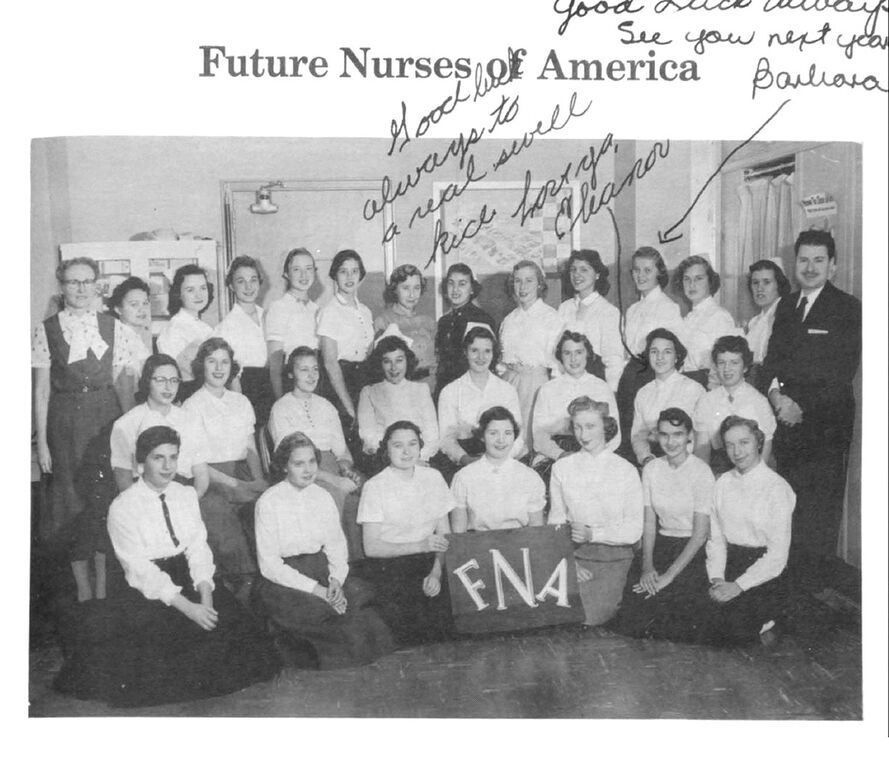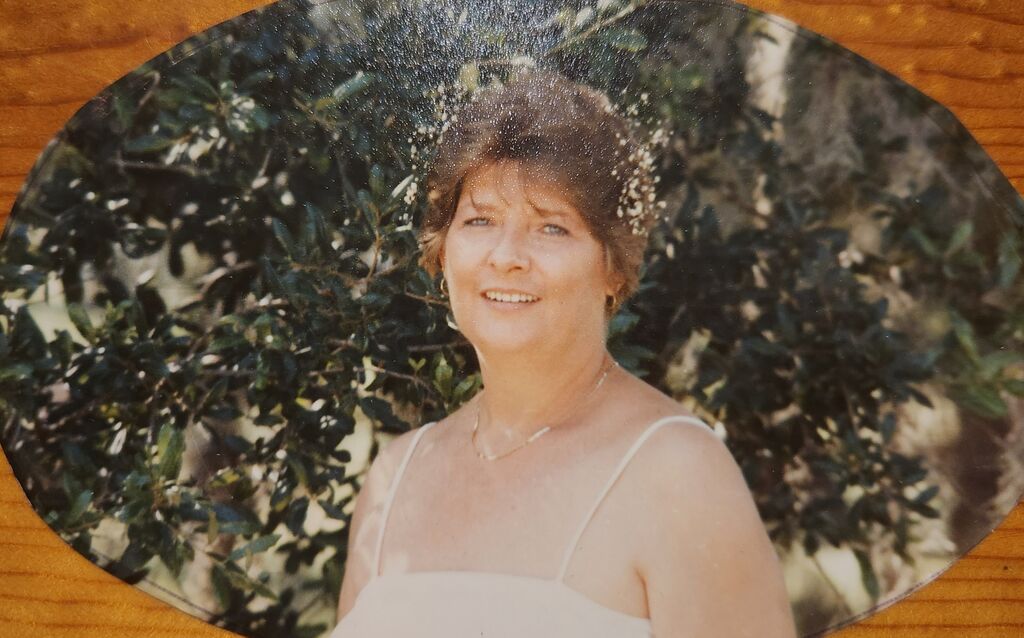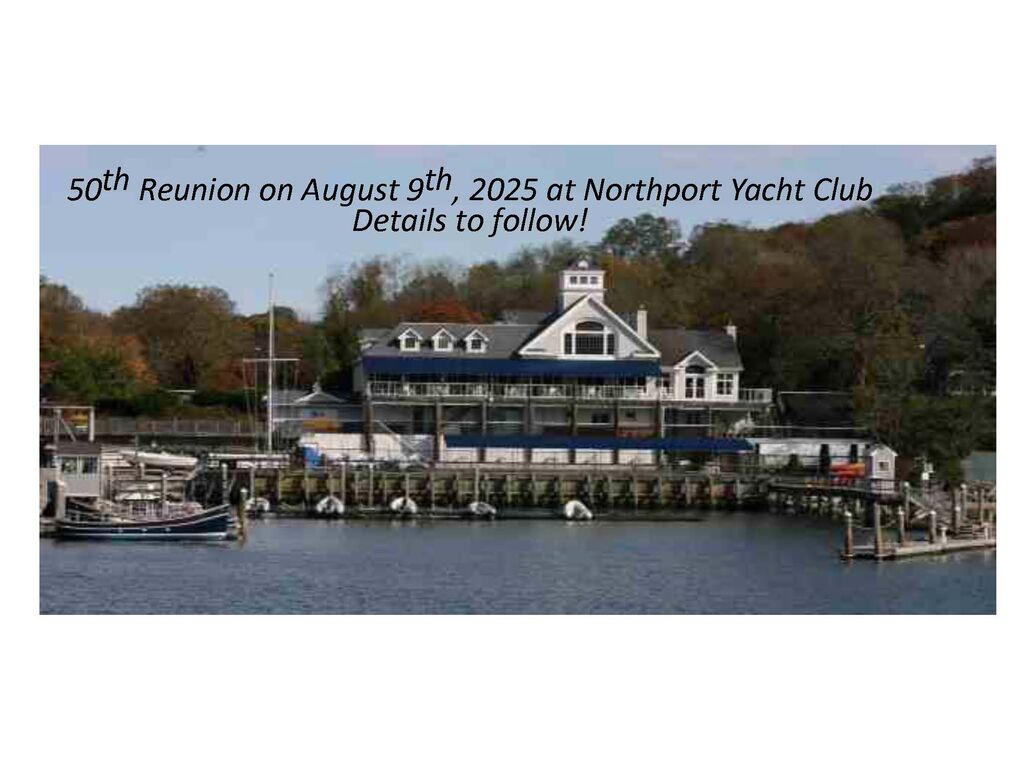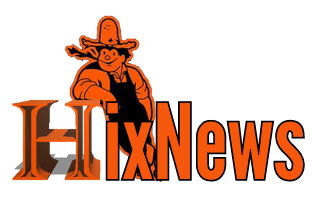 Newsletter for the Alumni and Friends of Hicksville High School - Hicksville, New York
Newsletter for the Alumni and Friends of Hicksville High School - Hicksville, New York
Dear Readers,
We hope you enjoy our latest issue of HixNews. Do you have any favorite memories of Halloween? Send them to us, along with pictures, for our October issue. Article contributions, suggestions, and news are always welcome and you will read some articles we received from readers this month! We would love to hear from you, too! Don't hesitate to get in touch with us at
- Your HixNews Team
View The Hix News Team
Editors:
- Wendy Elkis Girnis '77
- Stefanie Cedar Shames '77
- Ron Wencer '64
Webmasters:
- Bruce Scherzinger (spouse of Eileen Goldstein '77)
- Gail Schwartzman Mayer '73
- Matt Kennedy '08
- Roger Whitaker (Webmaster Emeritus)
- Karl Schweitzer '81
- John Maniec '64
- Susan Schuler Nolan '77
- Wayne Sternberger '71Editors Emeritus:
- David J. Rubin - '82, Elliot Gorlin - '63
- Valerie Pakaluk - '51, Henry Lichtenstein - '59
- Carol McCormick Konen - '73Founding Editors:
- Pat (Koziuk) Driscoll - '56
- Linda (Piccerelli) Hayden - '60
- Buffalo Bob Casale, '61
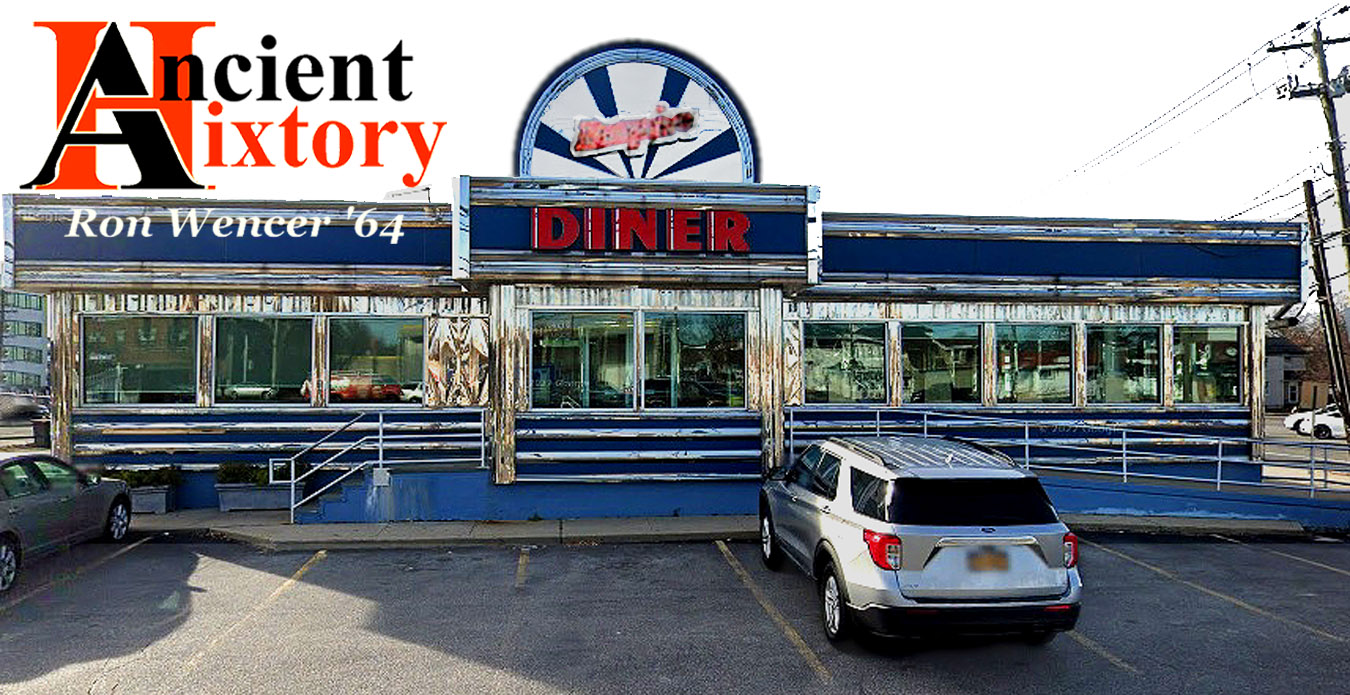 Introduction
Introduction
July’s Ancient Hixtory discussed the Hub Diner on East Marie Street, which appears to have been the first “dining car” eatery in Hicksville. That was nearly a century ago. In contrast, the latest incarnation of Hicksville’s Empire Diner is shown above. While this article is not going to cover the entire 90-odd years since the Hub began, it should get us, at least superficially, through the 1930s and 1940s, and then use the Empire as a lens for looking at the fast-changing world of 1950s Hicksville.
Now, back to the Hub Diner for a moment. Pete Foster, HHS Class of 1957, has shared with me some first-hand memories of a few local diners, for which I’m very grateful. He told me that John Dounelis, son of the owners of the Hub, was a member of his graduating class. Pete also mentioned that he and his late wife, Alice Davidson (HHS Class of 1959), first met in the youth program at Trinity Lutheran Church on Nicholai St. Later on, after attending services at the Church on Sundays, they would go out to eat nearby, not at the Hub, but at the Empire Diner.
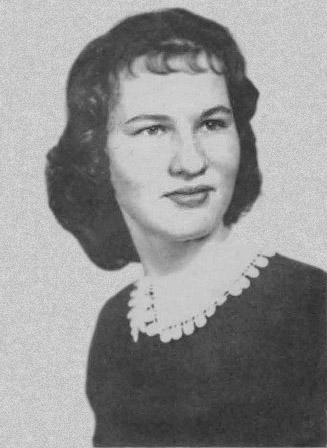 Alice Davidson, 1959
Alice Davidson, 1959 Pete Foster, 1957
Pete Foster, 1957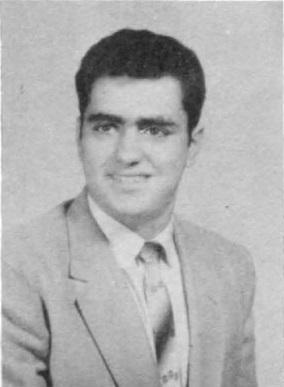 John Dounelis, 1957
John Dounelis, 1957For downtown 1950s Hicksville to have boasted two diners less than a quarter mile apart may seem odd to you, but consider this: there actually were THREE diners in the neighborhood. At that time, the Broadway Diner stood about 100 yards north of the Empire. Let’s look at how the local “dinerscape” had evolved after the Hub got going.
The Thirties and Forties
Because of the Great Depression, the 1930s were difficult for restaurants everywhere. Some elegant high-end spots survived – like the poor, the ultra-wealthy we will always have with us – but when the stock markets crashed, many lower and middle class families, and also many nouveau riche, instantly lost whatever wealth they thought they had. Compared to upscale restaurants, diners had a better chance of survival, as long as local manufacturing did not shut down – but not every diner, or every diner owner, would be able to stay in business.
In Hicksville, the Hub Diner kept going. After leaving his native Lesbos, future owner Harry Dounelis had first settled in Brookline, Mass. In the Greek immigrant community there, he learned all he could about running an American diner. Saving his earnings, and networking with other Greeks in the Northeast, he eventually found his opportunity in Hicksville. The location chosen for the Hub guaranteed a flow of movie patrons and firemen, two groups whose patronage would continue, albeit sometimes at reduced levels, even during the worst depths of the Depression.
In contrast, let’s consider the Hicksville Grill, at 32 Broadway. Never heard of it? Well, look at the red circle in this illustration, which shows the west side of Broadway, including the Triangle:
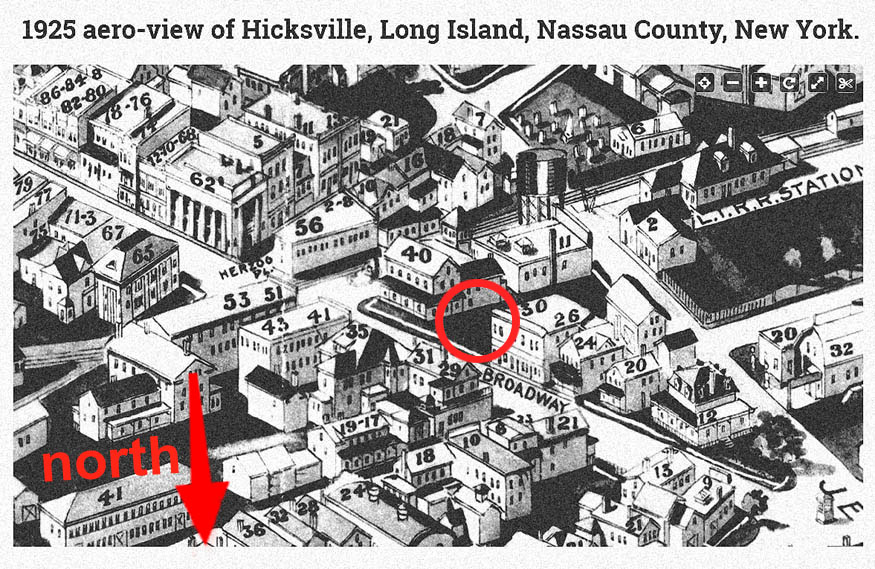
| Listing for 32 Broadway by Year(s) | |
| Hicksville Grill | 1929 - 1932 |
| John Diner | 1934 |
| Village Diner | 1935 - 1936 |
| Hicksville Diner | 1941 - 1944 |
| Empire Diner | 1948 - 1951 |
The circled empty space is where there soon would be a 32 Broadway. I do not know with certainty if a building was constructed on the lot, or if someone just “planted” a dining car there. I suspect that there was a building, one that blended in with the neighborhood, for had it been a dining car, I would remember seeing it when I lived in Hicksville. Incidentally, I know about the existence of 32 Broadway only from entries in old annual telephone books, as shown in the table here.
It appears that, from the Great Depression through the Korean conflict, many people went to 32 Broadway to eat. The frequent changes in business names, however, suggest that the owners of these eateries did not want to remain in business at that location.
In contrast, a prosperous wartime industry meant thousands of new employees who had to eat; new diners sprouted around the edges of industrial complexes. For example, the Halfway and Rainbow diners respectively served employees who used different gates on the vast Grumman property. Post-war, the local population was ballooning; the future of Hicksville’s diners looked good indeed.
The Empire Diner
As far as I can tell, the Empire’s original principal owner was Archie Kyriacou, an immigrant from Cyprus who actively promoted his business. In the late 1940s, when Hicksville resumed organized community sports after a hiatus during the war years, the Empire Diner softball team was often the best in the league. The diner earned praise from the Hicksville Sportsmen’s Club for its ongoing support.
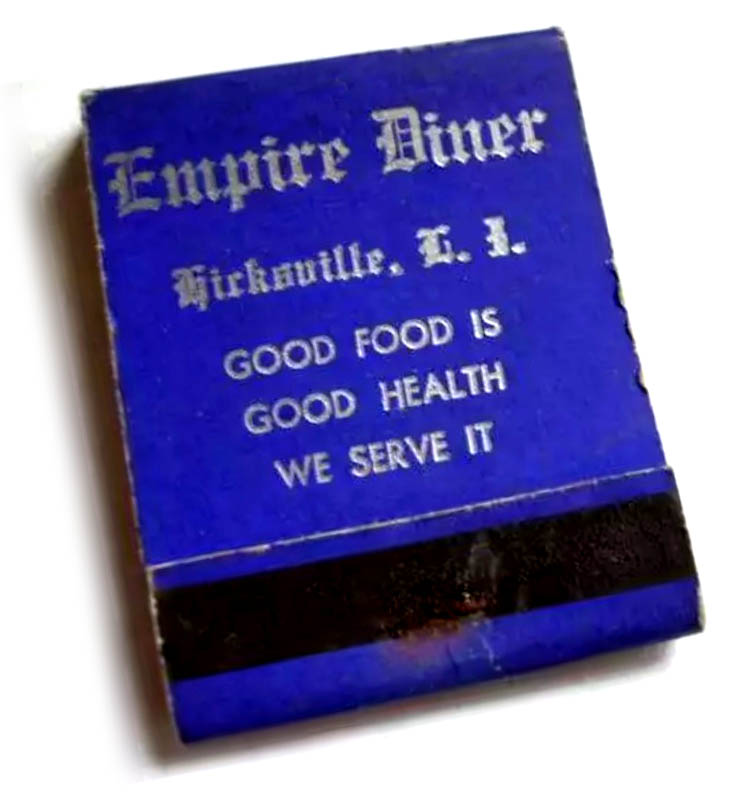
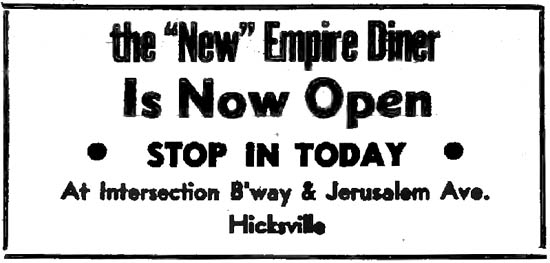 Kyriacou decided to upgrade his Empire in 1951. That May, newspapers announced that the diner would soon be getting a new “wagon” (i.e., pre-fabricated diner), which would be set down between Jerusalem Avenue and Broadway. The Triangle had seen many changes since that old Aero-View illustration was drawn in 1925. The big house at 12 Broadway was gone, as was the adjacent house at 20 Broadway. A Sunoco gas station now occupied the “point” at John Street, and behind it was a vacant lot. Come September, a new Empire Diner would open on that lot.
Kyriacou decided to upgrade his Empire in 1951. That May, newspapers announced that the diner would soon be getting a new “wagon” (i.e., pre-fabricated diner), which would be set down between Jerusalem Avenue and Broadway. The Triangle had seen many changes since that old Aero-View illustration was drawn in 1925. The big house at 12 Broadway was gone, as was the adjacent house at 20 Broadway. A Sunoco gas station now occupied the “point” at John Street, and behind it was a vacant lot. Come September, a new Empire Diner would open on that lot.
I remember seeing the Empire at that location in 1954 or 1955, and I thought it looked great (of course, I was only about 8 at the time). Although I think that Archie Kyriacou would have agreed with me, I also think that he was more concerned with its location than its looks. The new Empire offered easy access and parking to motorists. It was visible at a distance to drivers coming south on North Broadway. Just to make certain they noticed it, the illuminated words EMPIRE DINER “hovered” above the gas station, supported by a thin, graceful framework that was firmly planted on the diner property (see below). The Empire’s future at its new address seemed guaranteed.
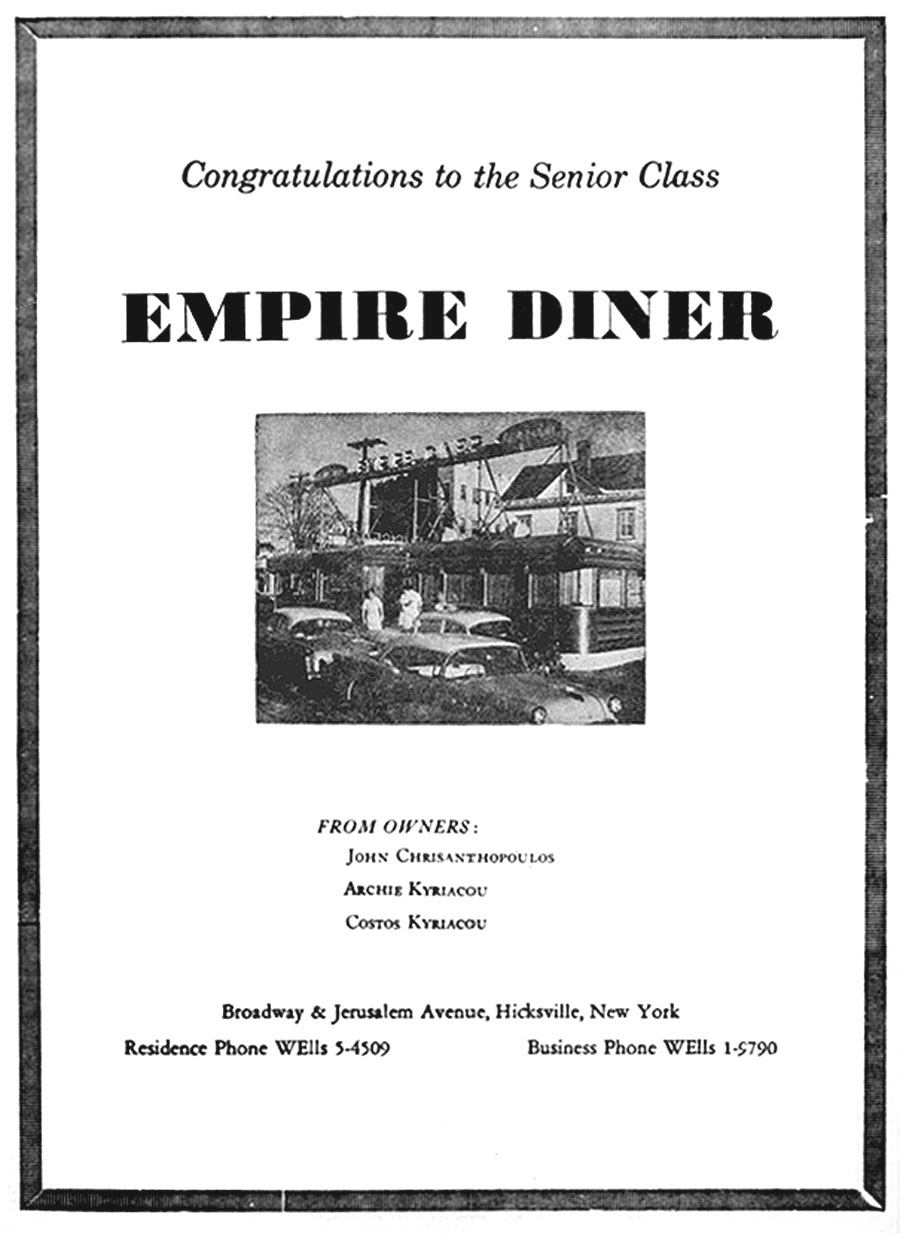 A reminder: If you click on this ad from the 1957 Comet Yearbook, a larger image will pop open on your screen. Note the Hicksville Professional Building in the background, across Broadway and to the south of the diner. Immediately behind the diner is 24 Broadway, an older house by then subdivided into multiple living quarters.
A reminder: If you click on this ad from the 1957 Comet Yearbook, a larger image will pop open on your screen. Note the Hicksville Professional Building in the background, across Broadway and to the south of the diner. Immediately behind the diner is 24 Broadway, an older house by then subdivided into multiple living quarters.
Foreshadowing the Destruction of 1967
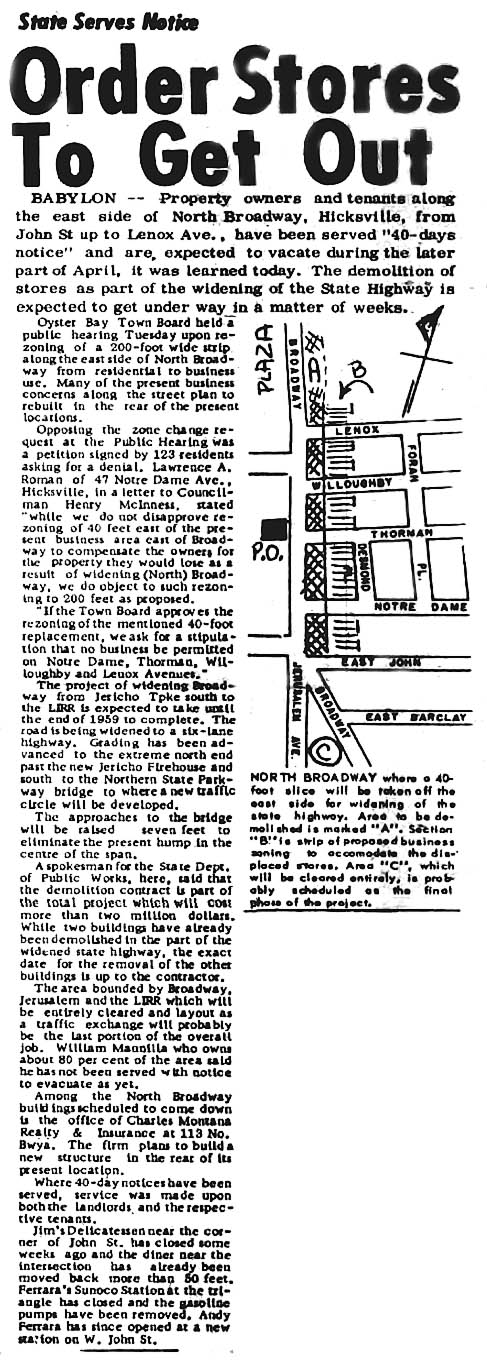 For years, the local Businessmen’s Association had fretted about the inevitable elimination of Hicksville’s grade-level crossings with the LIRR tracks. Eventually, it received verbal assurances that when the grade crossings were eliminated, the affected local roads would not be submerged in open cuts, cutting off automobile access to local stores.
For years, the local Businessmen’s Association had fretted about the inevitable elimination of Hicksville’s grade-level crossings with the LIRR tracks. Eventually, it received verbal assurances that when the grade crossings were eliminated, the affected local roads would not be submerged in open cuts, cutting off automobile access to local stores.
Unfortunately, the Association had worried about the wrong thing. In 1956, the Mid-Island Herald published an article about the possibility that, between the LIRR tracks and Old Country Road, buildings on the west side of Broadway might someday be demolished. As alarming as this would be, the article also had news of something that was certain: NYS had taken control of North Broadway. Because of sharply increased traffic attracted by the Mid-Island Plaza, Albany had decided to turn it into a six-lane road, all the way from Jericho Turnpike to the tracks at Hicksville Station. Many buildings would likely be demolished.
Archie K. would have been worried – yes, his diner could be moved if necessary, but no other lot in downtown Hicksville offered the same advantages the Empire enjoyed.
In late March 1958, the same newspaper published the final details.
Many businesses would have to leave; others – like the Broadway Diner at East John and North Broadway – might be able to stay, provided they could move further “inland” from Broadway. For the Empire, the news could not have been worse – the Triangle now was State land, and Albany wanted to flatten everything that stood on it. The Empire would have to move to an inferior location.
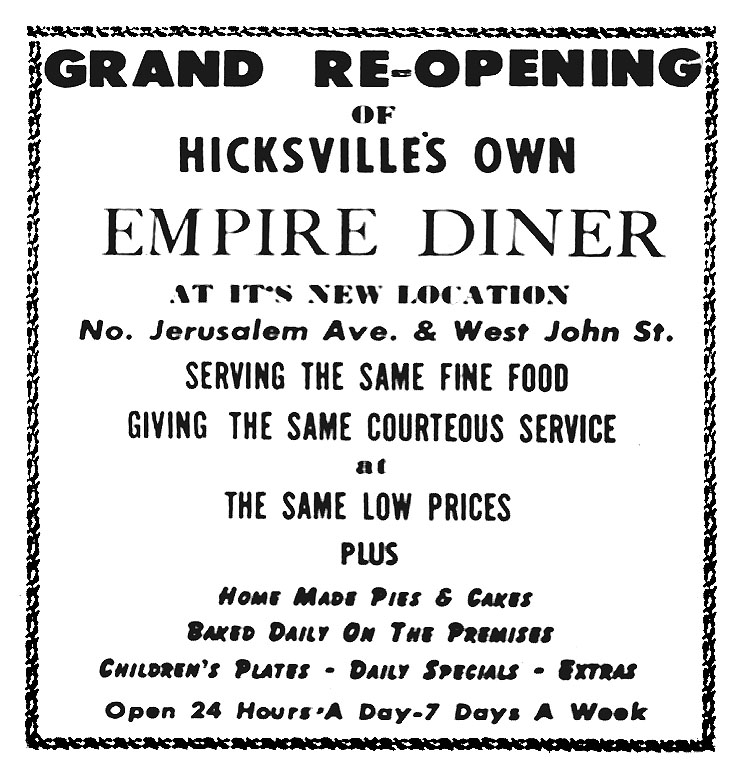 In the end, the Empire’s owner(s) did the best they could, and moved the diner across Jerusalem Avenue and around the corner to West John Street.
In the end, the Empire’s owner(s) did the best they could, and moved the diner across Jerusalem Avenue and around the corner to West John Street.
Moving to the new location felt like a step backward. A vacant house (which Kyriacou was not able to purchase as part of the new diner site, because it was tied up in probate) stood on the corner; the house and its foliage effectively screened the diner from passing traffic. Navigating the crazy intersection of John Street, Jerusalem Avenue, and Broadway during rush hours was not for the faint of heart. As time went by, the empty house on the corner became more of an eyesore. Archie Kyriacou’s frustration simmered, and a lot would happen as a result -- too much to fit into this article. His story will continue next time.
Until then, CIAO!
Appendix: List of Images and Their Sources
1. Empire Diner Today
Google Maps Streetview 2022 (modified by author)
2. Hicksville High School Graduation Photos
Hicksville Public Library’s History Archives
http://history.hicksvillelibrary.org/yearbook
1957, 1958 Comet Yearbooks
3. 1925 aero-view of Hicksville, Long Island, Nassau County, New York (excerpt)
Library of Congress Digital Collections
https://www.loc.gov/item/75694782/
4. Empire Diner Matchbook c.1950
ebay.com
5. “New” Empire Diner is Now Open
NYS Historic Newspapers, Mid-Island Herald, September 12, 1951
nyshistoricnewspapers.org
6. Congratulations to the Senior Class (advertisement for Empire Diner)
http://history.hicksvillelibrary.org/yearbook
1957 Comet Yearbook
7. Order Stores to Get Out
NYS Historic Newspapers, Mid-Island Herald, March 27, 1958
nyshistoricnewspapers.org
8. Grand Re-Opening
NYS Historic Newspapers, Mid-Island Herald, December 18, 1958
nyshistoricnewspapers.org
Could Every Town Be Like Hicksville?
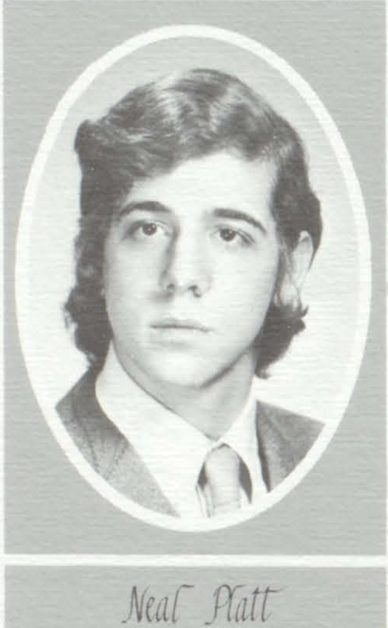 by, Neal Platt, Class of 1971
by, Neal Platt, Class of 1971
Editor's Note: Neal Platt gave HixNews permission to use his article, which was written in 2012. You may find some of the figures dated, but they certainly don't take away from the content. Enjoy!
When I was a kid in the ‘60's, Hicksville was a middle-class town that was still in the process of being built. Parts of town were giant fields of grass where we could play touch football all day long, and no one would tell us to take ourselves to the public schoolyard. A couple of times, when I was mowing the lawn or having a catch in our sideyard, I nearly tripped over some old horseshoe that had rusted there since the town consisted of nothing but potato farms.
Our town didn’t have a fancy section like some Long Island towns did, where rich people had lived in Great Gatsby manor houses since the ‘20's and looked upon the kids of newcomers as unwelcome riff-raff. To the contrary, the few who’d lived in our town for more than a few years were dirt poor, and still walked around in bare feet all summer, regarding us with suspicion primarily because we wore shoes all year ‘round.
In Hicksville, the kids were all thrown together, much as our dads had been during the Big One. The Second World War, which had ended only twenty years before, haunted us like a ghost whose only physical manifestation consisted of black-and-white photos of aunts and uncles we’d never meet because they’d been killed in the war or in the Holocaust, and dads who’d freeze up and never, ever talk about their war experience. (I didn’t realize until years later that the ones who were most tight-lipped were the ones who’d been right in the middle of battle, sometimes for months on end. Those guys were honest-to-God heroes, but you’d never know it from talking to them.)
Though most of us kids were enrolled in public school, the few in Catholic or Lutheran schools would join whatever pick-up game or sleepover the rest of us were having, so there was little distinction drawn between us even on religious grounds, except on Saturday and Sunday mornings, of course, when each of us would dutifully march to whatever religious observance our parents insisted on. As an assimilated Jew, I still remember being shocked a few times, once by a friend caught examining the top of my head for horns, and another time by one whose father had said that, although I seemed to play the piano well, I was really only imitating the gentiles, as Jews had no souls and were therefore incapable of appreciating music. In fairness to those friends and many others, I freely acknowledge that they dispensed with such hoary prejudices immediately, and I never saw any sign of such ignorance on them again.
Amidst all this egalitarianism, there were occasional flashes of excellence. The most conspicuous example was this one kid, only three or four years older than I was, who could play piano like the wind. Although my brother and I were considered talented, and took piano lessons from the same lady teacher as he did (Her name was Florence Neiman), when this kid booked the lesson before ours, we would drag our feet before going inside, mostly because, when you really listened to him play, you realized that, should you live another thousand years, you’d never, ever, ever play as well as he did already.
We’re talking about a fourteen-year-old kid who would absolutely nail a complex piece by Rachmaninoff, and throw in a few blues licks of his own just to drive the teacher crazy. Not only was he better than we were, he was better than she was, and she’d played Carnegie Hall. As we walked up the path to the studio, once in a while, the teacher would be demonstrating the proper way to play a particular passage, but you could always tell even from outside when it was the kid who was playing, because the teacher, talented as she was, would make an occasional mistake (unless it was a piece she’d recently practiced), and she had a gentle, feminine touch. When he played, he always knew where he was going before he got there (no matter that the notes were flying by in milliseconds) and had a natural mastery of dynamic range. When he was supposed to come down hard on the keyboard, he pounded with confidence and authority.
The kid was “Billy Joel,” whose name everyone initially mistook as “Billy Joe.” He was a polite, slightly retiring kid, and kind of small. And he had these big, weird eyes. Nobody looked like him, and he couldn’t look like anybody else, try though he might.
My brother and I shared a room until we were teenagers, and sometimes we’d lie in our beds at night and listen for the steam whistle of the Long Island Railroad. (Yes, they had steam whistles then.) As all brothers do, we’d talk about everything. Remember having so much in common with someone that you could literally talk about everything?
“You suppose Hicksville is just Anytown, USA?” my brother once asked in one of his more philosophical moods. “You know, just like every town in America?”
“Most ways, I guess,” I replied, always the great conversationalist.
“So, how are you and I supposed to make something of ourselves? I don’t want to be just another shlub in this town, some guy who goes through life just like everybody else, and never excels at anything.”
“Just because there are a million other towns like this one doesn’t mean you can’t excel, and have an extraordinary life,” I assured him. “Look at Billy Joel. He’s an incredible pianist. He’ll do great, I bet.”
“Yeah,” my brother said hesitantly. Then there was a long silence. “Sure, we think of him as special. But what if there’s a Billy Joel in every town in America?”
The silence that followed that remark was long, because, if every town in America had a Billy Joel in it, then, no matter what my brother and I might think, Billy wasn’t assured of success at all. And that could mean that less spectacular guys, like my brother and me, were doomed to anonymity, because we weren’t nearly as special as Billy. In this way, Billy’s success came to represent a kind of invisible ceiling on our own success. After that, although we were definitely rooting for him to succeed, it was partly for selfish reasons. Sure, America was a great country, with lots of nice towns. But Billy would show ‘em. He would shine anywhere. And that would give us hope that . . . so could we.
In the mid-1960's, America was embroiled in an escalating conflict in Vietnam, but, here at home, rock n’ roll ruled the airwaves. Although rock’s iron dominance over popular music had declined with the fading of Elvis’s masculine rockabilly, by 1964 the Beatles had reinvigorated rock and transformed it into a far more sophisticated and varied form. But one elemental thing remained the same about rock n’ roll: Its emblematic instrument was the guitar, not the piano. And Billy, and my brother and I, played the piano. Oh, sure, Jerry Lee Lewis had had his day, and there was still piano on Beatles and Monkees tracks, but in pop music the piano was an occasional instrument, not a staple. In rock, you were as likely to hear a clavichord or a piccolo trumpet as you were a piano.
And so came one day in the early Fall of 1966, or so I estimate, because I think I was thirteen. My mom was dropping me off for my lesson. As she chatted with Mrs. Neiman, I took my seat on the bench of the studio piano, leafing through sheet music, trying to locate the piece I’d half-practiced that week. While I pretended to puzzle over some complex musical notation, the two chatted privately, at what they considered a safe distance. I could have overheard the conversation at twice the distance, of course, and listened intently while pretending not to, because Mrs. Neiman was speaking in that hushed tone she’d use only when talking about her prize pupil, Billy Joel. He was considered a troubled kid, because he was so completely fixated on the piano that he might never graduate from high school.
“Don’t tell this to anyone,” whispered Mrs. Neiman, “as I wouldn’t want it to get around, but Rosalind put a padlock on the piano, and Billy has nowhere to play.” Rosalind was Billy’s mom.
“But he’s such a talented kid,” said my mom, “why would she do that?” Mrs. Neiman shrugged. “I suppose she wants him to go to college.”
“Does everybody have to college?” asked my mom, who sometimes seemed self-conscious because she hadn’t.
Now, before I mention how Mrs. Neiman responded, let me point out a couple of things. At that time, at least on Long Island, every Jewish family expected its sons, and possibly its daughters, as well, to go to college. And until that moment, I had no idea whether Billy was Jewish or not.
“Well,” replied Mrs. Neiman, “it’s kind of expected.”
“But I thought he was gentile,” said mom. “Is it expected in their families now, too?”
Mrs. Neiman frowned skeptically, by which I understood her to mean that my mom should have known (or at least expected) that any pianist as talented as Billy would have to be at least partly Jewish. “He’s Jewish,” she confirmed. Then, they started talking about something else. My interest faded, and my attention wandered.
Eventually, my mom left, and Mrs. Neiman assumed her accustomed seat on a swivel chair to my left. Smiling as always, she said: “Okay. Let’s see how you’ve done with this piece.”
I took a moment to take in her appearance, as I’d just realized as I sat there that afternoon that I wouldn’t be taking piano lessons much longer. I’d joined a rock band, and found that, with the keyboard and theory skills she’d already given me, I could play any pop piece by ear . . . with enough work. She was always made up and dressed impeccably, if a bit behind the times. As late as 1966, she still wore high heels with metal taps that clacked when she walked, poodle sweaters, and pleated skirts, plus a tasteful amount of perfume that always made my nose itch (and sent my brother into sneezing fits, as his allergies were always far worse than mine).
I began to play the piece (better than I expected, considering the little practice I’d done that week), when Mrs. Neiman’s phone rang inside the residence to which her studio was attached. Although she’d felt it unacceptably obtrusive to have an extension phone installed in the studio, she never failed to take a phone call, which meant that any phone call would interrupt the lesson. She rose, and pardoned herself. Clack, clack, clickety, clack. She walked the length of the studio’s wooden floor, turned the knob, and leaned into the solid-core door to the residence, shutting it firmly behind her. A moment later, the phone stopped ringing, and I assumed she’d answered it.
I’d sat there alone only a few seconds when something flashed in the four-inch-wide vertical window on the entry door across the piano in front of me. It was the face of a young guy, a few years older than I was. He was acting very strange, peering momentarily through the window, then dodging from view, then appearing again for just a moment. He was obviously trying to figure out whether Mrs. Neiman was sitting next to me. And those weird eyes could belong to only one guy. Billy Joel.
Evidently deciding I was alone, he opened the door and strode up to the side of the piano, as though in a hurry. “You’re Jack’s little brother, right?” he asked.
“Yeah. Hey, Billy. How’re you doin’?”
“Okay,” he said impatiently, glancing at the door to the residence. He pointed to the bench I was occupying. “Mind if I play?”
I’m kind of ashamed to admit that, until that moment, it hadn’t occurred to me that he’d come to the studio looking for a decent piano to play, his own having been padlocked. “Of course,” I said. “Be my guest. I’d love to listen.” I rose, and stepped away from the piano. He smiled, and took a seat on the bench.
I gave him as much privacy as I could, plopping down on the studio sofa, leafing through Esquire magazines in search of pictures of scantily clad women. Who could resist?
Billy played up a storm. He played so well and so emotionally, in fact, that I got lost in the music, and only pretended to look at the pictures. (If you’ve never been an adolescent male, it’s hard to impart just what an accomplishment that is.) At this point, it occurred to me that Mrs. Neiman (who had ears like a cat, and was pretty sharp in the noggin) simply had to know that Billy was using her forbidden piano. I even began to suspect that the phone call was nothing more than a prearranged signal between the two of them.
A few minutes later, Billy stopped playing, and I heard a psssst!, as though someone was trying to get my attention. I looked toward the door to the residence, but it was still firmly shut.
“Hey, kid!” The whisper came from the direction of the piano. Billy leaned forward so he could see me past the lamp. He didn’t know what name to call me, and evidently thought Jack’s little brother might be a little condescending. “Want to hear something?”
At this point, I felt this was some kind of setup and I was the only one not “in on it.” I mean, he’d just been playing like a concert pianist. And now he’s whispering? Who was he fooling? His piano-playing was at least as recognizable as his voice. I looked at the door to the residence, but there was still no sign of Mrs. Neiman, and I wondered whether she was extending her absence just to let Billy play.
“Sure,” I said, as I rose and concealed the Esquire magazine behind some more innocuous reading material on the coffee table.
Billy beckoned me to stand by the piano. He regarded me a moment, as though equivocating. “I want you to listen to something,” he said. “I wrote this.” He took a deep breath and lowered his head to position his hands on the keyboard.
The invitation alone was enough to leave me stunned, but probably not the way you’d expect. Here was Billy Joel, who would obviously be a lifelong musician, and he was about to play me something he’d written himself. Who the hell was I? For all I knew, it was the first time he’d played anything original for anyone. Laugh if you must, but my fondest wish was to run. I’d come here for a mundane piano lesson, and now I was standing here by myself, a jury of one, with this terrific musician’s soul in my hand. I’d never so much as tried to write anything myself, and realized that I had no idea how to judge a new piece of music. In fact, it had always taken me three or four hearings to understand even the simplest piece of music well enough to know whether I liked it or not. (It still does.) So, no matter how good or bad it was, I was going to have to show some enthusiasm, whether I felt it or not.
And then Billy did something else I would never have expected. He sang while he played! (It was as though a neighborhood cheerleader had invited me into her basement to see her new cheering routine, but did some exotic dance instead.) And he wasn’t singing in his own voice, either, but in a voice reminiscent of . . . Ray Charles! Now, in 1966, teenagers did not consider Ray Charles to be cool. His appeal was very definitely to grownups, so I found Billy’s choice of that voice quite strange, to say the least. (I had just taught myself how to play and sing the Beatles’ piano tune For No One, and, like every other kid who learned it, I imitated Paul McCartney’s voice, affecting as much of a Liverpool accent as possible without sounding excessively imitative. It would never have occurred to me to imitate Ray Charles. But here was Billy doing a Ray Charles tribute.)
Billy’s lyrics were nothing like Ray Charles’, because Billy’s included numerous references to several people he knew (but I didn’t). And the piano accompaniment, instead of sounding like Debussy, reminded me of a simple sea chanty. In a minute, he stopped and looked to me expectantly. I was flabbergasted, and had no idea what to make of it all. So I just smiled, and said. “Really cool!” And then, to draw attention away from my bewilderment, I asked him how long he’d been writing.
As he doodled on the piano, he replied. “Not long. What do you think?”
“I don’t know any of those people you sang about, but I like it a lot.”
Then, as though by some form of extrasensory perception, he detected that Mrs. Neiman’s phone call had ended. He shot up from the bench, once more resumed his harried expression, and wagged a finger at me. “Don’t tell her it was me!”
“I won’t,” I replied, “but she’ll know, anyway.”
“Just don’t tell her,” he repeated, and was out the door in an instant.
I had barely resumed my seat on the bench when Mrs. Neiman opened the door from the residence, and regarded me more than a little skeptically. I could see she was equivocating about whether to ask me the obvious question, and so I gave her my most innocent smile, which was never quite as innocent as I intended.
“That wasn’t you, was it, Neal?”
“How do you mean?” I replied, wide-eyed.
“Playing,” she said. “That wasn’t you playing the piano just now.”
“What makes you say that?”
“I know you’re good,” she said, “but not that good.”
I let my mouth drop open, and looked as insulted as I could. “I don’t see how you could say such a thing to your devoted student.”
“It was Billy, wasn’t it?”
I smiled. “Billy who?”
She nodded knowingly. “Okay. Let’s resume the lesson.” And we did. And I finished playing the piece, and knew that it was pretty good for someone who didn’t practice that much. But I also knew I’d always be something of a disappointment to Mrs. Neiman, who knew what it was like to have a really first-rate student as devoted to the instrument as she was. That wasn’t me.
I think I attended a few lessons after that, and then gave up lessons altogether. I never gave up the instrument, though, and played and sang in rock bands in junior high, high school, college, and, after a fifteen-year hiatus, I’ve played in public to this day.
Billy did better in the music business. He’s had thirty-three Top-40 hits, and has sold more than 150 million records worldwide, writing some of the funniest, and some of the most honest lyrics ever written to a rock beat. Although I’ve now met many of the people mentioned in his songs, it doesn’t matter, as it’s long been clear that his references to specific people never detracted from the universality of his lyrics, any one of which can still bring us back to the days when the people who fought the Second World War bought their first homes, and settled down to enjoy the fruits of their labors. And our generation had a blast.
Many years later, Billy returned to Hicksville High School and got his diploma.
Billy was not the only famous person to emerge from Hicksville. Howie Blauvelt, Billy’s bass player in The Hassles, went on to earn a gold record of his own.
And when Becker and Fagen were looking for a guitarist “with jazz chops and no hangups” to play with Steely Dan, they drove all the way from New York to a basement in Hicksville, where they found Denny Dias. Lorraine Bracco, a star of both Goodfellows and The Sopranos, first graced the stage of Hicksville High School. And the list goes on.
As for me, I went on to become a lawyer. In fact, I’ve been a Special Professor of Law at Hofstra Law School for thirty years now. I’ve also taken to writing novels, and my main character, Noah Ames, reminds me a little of Billy (and myself) in that he is a Jew successfully making his way in a land dominated by non-Jews.
Of course, I still play rock n’ roll, which has many of my legal and academic colleagues scratching their heads, because law and pop music seem such an odd combination of activities.
But, hey. I don’t come from Anytown, USA.
I’m from Hicksville.
© 2012 Neal Platt
Chapter 1 of Tales from the Cage: Growing Up in 60s Suburbia
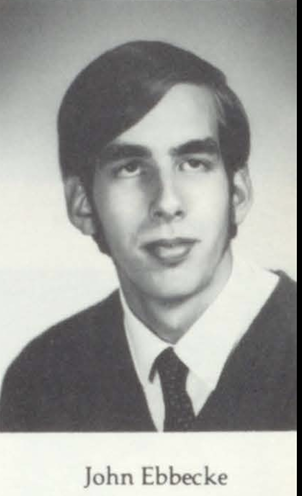 by, John Ebbecke, Class of 1972
by, John Ebbecke, Class of 1972
Editor's Note: Thank you to John Ebbecke, Class of 1972, for granting us to permission to publish Chapter 1 of his book, "Tales from the Cage", about growing up near Woodland Avenue. The book talks of his lessons learned from the schoolyard cage where he spent a good amount of time. The book is available on Amazon or B&N Digital.
Chapter 1 "From the Crib to the Cage"
When the greatest generation got home to New York City, they quickly had money to spend and hormones to satisfy. In the early 50s suburbia began to mass produce kids, as well as developments like Levittown, NY. My parents bought a house in a neighboring hick town built amongst the potato farms outside the Big Apple. It was literally called "Hicksville".
My parents would have four wonderful children, but in 1954 possibly their greatest event was the arrival of me. It was also the year they bought their house, and the year my dad began a 34 year career at Grumman Aircraft. The firm would later build the LEM that landed on the moon. For the young-uns out there, America was there back in 1980. It's not a new place we are returning to forty years later.
1950s-60s Hicksville was a great place to grow up. Every house pretty much had a wise cracking kid. Neighborhoods actually working together. Adding soon to be hopped over hedges, cement landscape to ride and play on. Suburban legend was overheard during evening gatherings of moms on lawn chairs in driveways. But for this episode, I'd like to fill you in on the center point of my youth. The schoolyard two blocks away and specifically, "The Cage".
Our school was Woodland Avenue which was odd in itself because as quickly as the next, and our development became connected, that street ceased to exist, because it became the extension of Ketchams Road. I guess Farmer Ketchams threw that in the contract when they sold the potato fields from whence the development came. There we would have street football games, that were supposedly touch, not tackle. You know, go down to end of the neighbor's house, push off their driveway curb, bounce off the parked Studebaker, and catch the pass before getting road rash from a fall on the asphalt. Oh and watch out for the German Shepherd at the corner house that likes to hop the three foot cyclone fence.
Passing cars would interrupt games. Often we would yell, "whadduh ya think dis iz, Grand Central Station", which makes no sense at all, since that was and is a train station. But since we were just dumb ass kids playing football on asphalt, maybe not much made sense? But I digress. Some drivers would ask for directions to extinct Woodland Avenue. We would respond by saying there is no Woodland Avenue but there is a school two blocks away with that on the sign. For those driver minds, it certified their impression of us as dumb ass kids.
Sometime around 1960 or so, Woodland made an addition to our schoolyard, "The Cage". Yeah, we already had a big skinny slide that was like three times higher than the park ones. We routinely climbed up the slide backwards on that nice hot curving sheet metal. Maybe a couple broken arms from falls on the hard dirt but don't think any broken necks. And of course, we had high monkey bars to hang and flop from. Again, don't think anyone was killed on them. Or maybe the kid down the street didn't just move to another town like Mom said?? I mean she did tell us when our first dog "King" got too big, they brought him to a "farm"?? But I digress again.
Anyway, "The Cage" was added and quickly became the center point of many a Woodland youth including me. It was about a twelve foot rectangular cyclone fence that enclosed two basketball courts. It was blacktop with a raised bump the entire length of the fence, and slightly sloped towards a middle drain. Our kid suburban legend was that those two last features were designed in winter to enhance formation of a ice rink. But again, we were dumb ass kids. It most likely was designed to enhance drainage. Ironically, besides countless variations of 11 hoops, full court and half court, games of Horse and 21, it was also home to street hockey. And to games of "automatics" baseball. And glorious hours of myself being a ruthless dodge ball king!!
More importantly, there was one gate out or in!! This personified our youth. While The Cage was a world inside protected by cyclone fencing, once you entered it to enjoy its playground joys, you also had to remember there was one way out. To get to that gate of the outside world, you had to wade thru the growing pains of your fellow kids. Sometimes by being cool. Sometimes by being street tough. But always great memories to wade thru.
Excerpt Chapter 1 courtesy of: Tales from the Cage: Growing Up in 60s Suburbia
Copyright © 2023 by John Ebbecke All rights reserved
Etcetera for September 2024
*Submitted by Susan Shuler Nolan, HHS '77:
Just have to say what a great article Wendy wrote on Grumman. I had the good fortune to work there for 13 years prior to the sale to Northrop.
Met some pretty amazing people while there. The VP who headed the lunar module program. The folks that sold products all over the world. And even Fred Haise. In gratitude for the module saving his life, he worked there too.
Participated in many a Round Table at Grumman where you would meet management from all over the company. It was a fairly intimate gathering. I remember one in particular where the hostess advised me there was someone at the table who remembered me from Hicksville High. Was shocked to see Scott Crosby there. Was 16 years since I'd last seen him. Was funny!
I remember the sound of the E-2C flying over my house early in the morning. I am always reminded of that when the Bethpage Air Show takes place and the E-2 comes in to participate. A real workhorse of an aircraft. Have seen it land right outside the window of my office. Brings back fond memories.
In Memoriam
*Bruce Patoka passed on October 11, 2023. Class of 1968. (Submitted by his brother, Mike Patoka.)
***
Barbara and I became lifelong friends, as did Len Cuccaro, whose death I reported to you recently. She was part of the Hicksville HS Class of 1958. After graduation, she became a nurse, and dedicated herself to working in the field of nursing for more than 50 years before she retired. Barbara passed away in October of 2021. Her obituary can be found online at www.tributearchive.com/obituaries/22933528/barbara-k-benvenuto
As there is no 1958 HHS yearbook online, we have no yearbook picture of her. Pete suggested using the group photo of the FNA in the 1957 yearbook. BTW, in the online copy, Barbara labeled herself! I've attached it here for your convenience.
This is a "Save the Date" for the Class of 1975's 50th Reunion next year. We have an active, private Facebook group at https://www.facebook.com/groups/67266179651 (Hicksville High School Alumni Class of 1975) that will have the most current information. The group needs approval to join and is currently at nearly 500 members.

